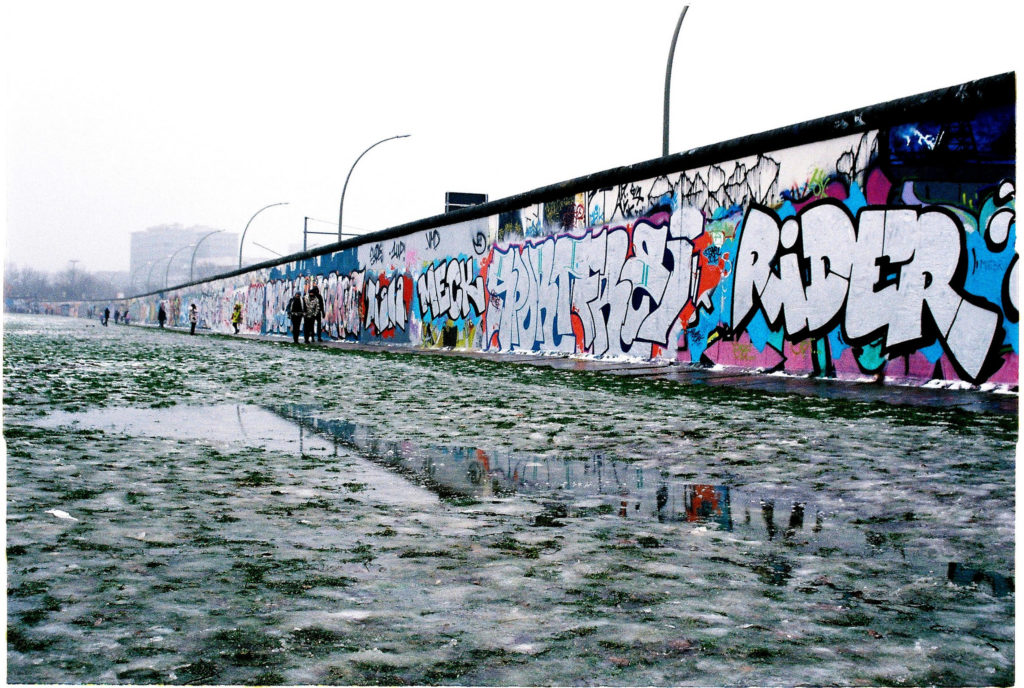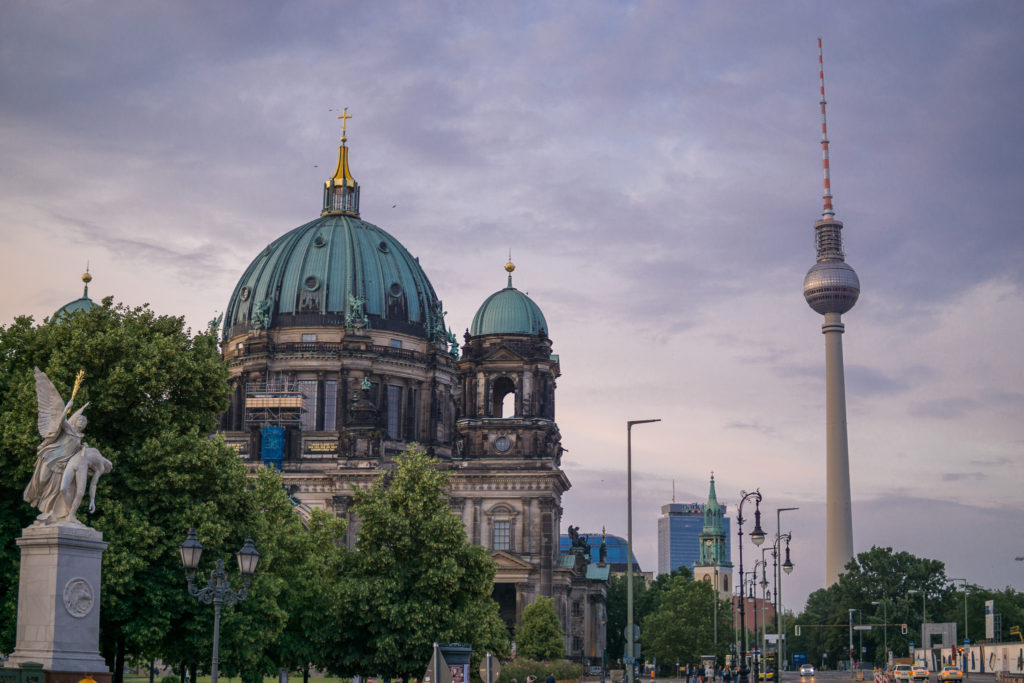I am excited about the opportunity to go to Berlin next week as one of the “experienced group leaders” at the International Training Tour that will be held there. As a high school history teacher, I am very much aware of anniversaries of important events. August 13, 2011 marked the 50th anniversary of the building of the Berlin Wall. On that morning in 1961, people in East Berlin found themselves separated from everything in the West by barbed wire that would eventually become a 103-mile- long wall guarded by 300 watchtowers. The Berlin Wall “fell” on November 9, 1989. Of course, there were many important events that preceded the opening of the Berlin Wall, including President Ronald Reagan’s June 1987 demand, “Mr. Gorbachev, tear down this wall!” An excellent book to read about the rise and fall of this Cold War symbol is The Berlin Wall: A World Divided, 1961-1989 by Frederick Taylor.
My first visit to Berlin was in the summer of 2007 when I attended the National History Day Program’s first international teacher institute. Ten American teachers joined seven German teachers in an intensive eight-day course of study of German emigration in Hamburg and the Cold War in Berlin. Two of the German teachers were from the former East Germany. Our German colleagues participated in a program sponsored by the Korber Stiftung Foundation called the Federal President’s History Competition that is similar to NHD. As history teachers, we had a great deal in common. We examined and compared the history curriculums in our countries, and we shared our teaching experiences. We also asked our German colleagues about what it was like to grow up in a divided country.
After that institute, I knew I wanted to return to Berlin with my students. My 2009 tour, Berlin, Prague, Krakow, and Budapest, made its first stop in Berlin. It was a pretty neat moment for all of us when we stood in front of the Bradenburg Gate, now an iconic symbol of freedom. I had to point out to my students the nearby Hotel Adlon where Michael Jackson dangled his baby son, “Blanket” from the balcony of his hotel room in November 2002. Along with the history, you just need to work in the popular culture for your students. We caught up with Michael Jackson’s “Bad” self at the end of our tour when we visited the Marzipan Museum in Szentendre, just outside Budapest. Imagine a life-size figure of “the King of Pop” made completely out of marzipan!
During my first time in Berlin, I studied the Cold War through a series of lectures that presented both the American and German perspectives. The field trips were definitely off the beaten path. After a lecture on the atomic protection shelter program in the 1950s, our group toured an underground bunker that was to be used in the event of a nuclear attack. Surviving in that subterranean world did not seem to be very appealing, but certainly preferable to the alternative. If you are interested in taking your students on that tour, you should contact the Berlin Underground Association.
After a lecture about the Stasi, the East German Ministry of State Security, we visited the Stasi record office and archives and were given a glimpse of what it must have been like to live in East Germany before the fall of the Berlin Wall. We were also led on a two-hour guided tour of the Stasi prison (the Hohenschonhausen Memorial Center) by a former inmate. According to Simon Wiesenthal, the famous Nazi hunter, the Stasi were “worse than the Gestapo.” The prison operated between 1951 and 1989, and held mainly political prisoners who were subjected to both psychological and physical torture. All of the teachers in my group were drained after that tour. Touring the prison might not top your list of things to do in Berlin, but if you are interested in the history of the Cold War, then you will not be disappointed.
I visited the Museum of The Wall at Checkpoint Charlie during both of my trips to Berlin. Yes, it is a bit “touristy,” but I would go there again. Checkpoint Charlie was one of three points in the Wall where you could cross from West Berlin to East Berlin. (Named for the first three letters of the alphabet, the other two were called Alpha and Brava.) It’s been featured in many spy novels and films of the Cold War era. The original Checkpoint Charlie booth is in a museum, but a replica is manned by “fake” American and East German soldiers. I’ve always been impressed by men in uniform, so I’ve had my souvenir photo taken with these guys. The museum has lots of information about the history of the Berlin Wall, and it is crammed full of artifacts and displays about the creative and ingenious ways people tried to escape to the West. I’m glad that a visit to this museum is included in the EF itineraries.

Katarína Chovancová/Via Flickr
What is left of the Berlin Wall? Not much. There are at least three sections of the Wall on display around Berlin and rows of cobblestones denote where the Wall once stood. Huge chunks are on display in museums and there is even an impressive 4-ton piece of the Wall in front of the EF Center in Boston. I’m sure you could even buy a piece of the Wall on eBay. Our German colleagues in 2007 gave all of the American teachers a postcard containing our own piece of the Berlin Wall.
Berlin is a fascinating city for students and teachers. I’m counting down the days before I get a chance to return. If you are doing the same because you are also going to Berlin in the future with your students, you might want to read Frederick Taylor’s book and watch two German films that will teach you something about Berlin’s Cold War past.
Goodbye Lenin! (2003) is the story of a young devoted East German man whose mother has just come out of a 12-year coma in 1990. To protect his mother’s frail health from any shocks, the son goes to elaborate lengths to hide the fact that their former life in the German Democratic Republic is no more. The mother was an ardent member of the Communist Party who had no clue about all of the events that took place while she was in a coma. Goodbye Lenin! is an excellent (and amusing) film that shows the stark differences between East and West Germany before reunification.
The Lives of Others (2006) is set in Berlin in 1984-1985, a time when very few East Germans enjoyed truly private lives, thanks to the Stasi. Life in the German Democratic Republic was anything but democratic. The GDR was a dictatorship and the Stasi kept the population, no matter how famous or obscure, under control. The film focuses on a Stasi agent who keeps a famous playwright and his girlfriend under strict surveillance. The actor who portrays the Stasi agent once accused his first wife of being a Stasi informant.
No matter what your interests happen to be, have a great trip to Berlin!
Readers, what’s on your list of “must-see” places and sights in Berlin?
Related articles

